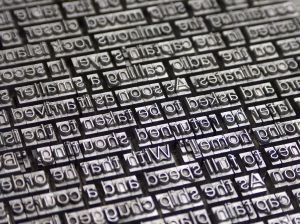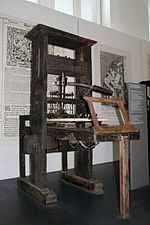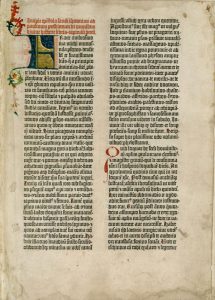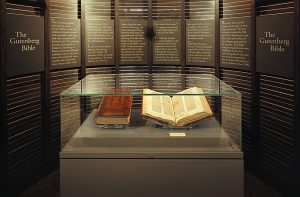We love parties here at the Free For All–any one who has seen the giant cake in the Main Library’s lobby in honor of George Peabody will be able to attest to this fact. And we get really excited to celebrate the birthdays of author, composers, and other artists.

But today is a special birthday, dear readers. It’s the birthday of the printed book itself.
Though details aren’t fully clear, scholars accept February 23, 1455 as the date on which the printing of the first Gutenberg Bible was completed on the movable print press invented by Johannes Gutenberg. We don’t know when Gutenberg started his Bible, but it seems to be sometime after 1450. We do know that the 31-indulgence (the permission to print, granted to Gutenberg by Pope Nicholas V) was printed on October 22, 1454–making it the first dated document ever printed on a movable type press.

Gutenberg himself was a goldsmith by profession, and brought those talents to inventing the printing press. He also invented the hand-molds that allowed him to create the letter blocks that were standard in size and small enough that they could be fitted into a matrix (the actual lines of type). By so doing, he was able to ensure that the letters on every page were the same size, the lines of type were all equidistant from each other, and that pages of text could be organized and changed comparatively quickly (relatively speaking).
This achievement, in and of itself, was enormous. Up to this point, individual letters had to be cut by hand over and over again–and more ornate letters could take up a day to craft. And when you consider that each page contained roughly 2,500 letters, you can imagine what it meant to create a letter that could be used over and over again. In the case of the Bible, which required not only capital and lower-case letters, but also punctuation marks aplenty, it is assumed that Gutenberg and his workers created approximately 290 different molds, and were able to set and produce six pages at a time.
The book itself was a late fourth-century Latin translation of the Bible known as the Vulgate, that became the Catholic Church’s officially promulgated Latin version of the Bible by the sixteenth century. Originally, Gutenberg was passing each page through the press twice, once in black ink and once in red ink to emphasis certain words in the front. This process is known as “rubrication”, and can be seen in the Bible page below, as well as in a number of Bible editions to this day.

The book was a work in progress and, in the earliest examples of his bible, it is possible to see Gutenberg’s interventions. It took time, not only to set the type, but to wait for the ink to dry (the ink he used was oil-based, rather than water-based, as it stuck to the print and the pages vbetter). As a result, Gutenberg decided to pass the pages on to professional rubricators to color the words that needed to be red in by hand. Later, presumably in order to save paper, he minimized the spaces between the lines of text in order to fit 42 lines onto the pages (the earlier pages had 40). When Gutenberg had to increase the print run of his Bible, he had to reset all the pages, so the later versions of this Bible have 42 lines on all their pages.
Though the Catholic Church seldom cultivated a reputation of accepting scientific progress or social change, it actually embraced Gutenberg’s invention with enthusiasm. Indeed, most of the detail we know about that first book comes from a letter from Enea Silvio Bartolomeo Piccolomini, who would become Pope Pius II three years later. He was a cardinal in Germany in 1455, and wrote to the then-Pope Calixtus III:
All that has been written to me about that marvelous man seen at Frankfurt is true. I have not seen complete Bibles but only a number of quires [a unit of measurement equaling about 25 pages] of various books of the Bible. The script was very neat and legible, not at all difficult to follow—your grace would be able to read it without effort, and indeed without glasses.
Gutenberg’s book changed the world, quite literally. By making it easier to print and reprint materials, information was easier to disseminate; more and more people had access to read, and more and more people learned how to read. The Reformation happened because it was possible to print the Bible in more and more languages. Revolutions turned on posters and pamphlets produced in small presses. Modern Libraries exist because it is possible to make books quickly and cheaply.
 The book itself proved remarkably long-lasting, as well. Historians estimate that the first printing of the Bible was between 160 and 185 volumes. Today, 49 copies are known to exist (although on 21 of those are complete, as many copies are missing some pages or passages). Because many institutions and collections own fragments of Gutenberg Bibles, it is assumed that another 16 copies are in pieces around the world, as well. I had the enormous good fortune to work in a library that had a complete Gutenberg Bibles, and a 100% reproduction that we showed to people in order to preserve the originals. When I was first shown where it lived, I had expected something…plain? Printed? Familiar? Believe me when I tell you it was nothing like what I expected. The Gutenberg Bible is stunning. Because he still employed rubricators and artists, each page has illumination and hand-drawn details that bring the printing to life, and, because the ink was so rich in metal and oils, the color remains vibrant to this day. If you don’t believe me, then take a look here Gutenberg not only produced the first printed book but, by many standards, he also created one of the most beautiful. If you don’t want to take my word for it, check out this digitized Gutenberg Bible from the Harry Ransom Center at the University of Texas at Austin, and have a look through the book for yourself!
The book itself proved remarkably long-lasting, as well. Historians estimate that the first printing of the Bible was between 160 and 185 volumes. Today, 49 copies are known to exist (although on 21 of those are complete, as many copies are missing some pages or passages). Because many institutions and collections own fragments of Gutenberg Bibles, it is assumed that another 16 copies are in pieces around the world, as well. I had the enormous good fortune to work in a library that had a complete Gutenberg Bibles, and a 100% reproduction that we showed to people in order to preserve the originals. When I was first shown where it lived, I had expected something…plain? Printed? Familiar? Believe me when I tell you it was nothing like what I expected. The Gutenberg Bible is stunning. Because he still employed rubricators and artists, each page has illumination and hand-drawn details that bring the printing to life, and, because the ink was so rich in metal and oils, the color remains vibrant to this day. If you don’t believe me, then take a look here Gutenberg not only produced the first printed book but, by many standards, he also created one of the most beautiful. If you don’t want to take my word for it, check out this digitized Gutenberg Bible from the Harry Ransom Center at the University of Texas at Austin, and have a look through the book for yourself!

So today, when you pick up a book–we hope it is a Library book, of course, but any book–take a moment to celebrate the genius, the time, and the love that went into creating it, today, and 562 years ago today. Because if that doesn’t deserve cake, I don’t know what does.
And if you’d like to learn more about Gutenberg and his books, check out Gutenberg : How One Man Remade the World with Words by John Man!

